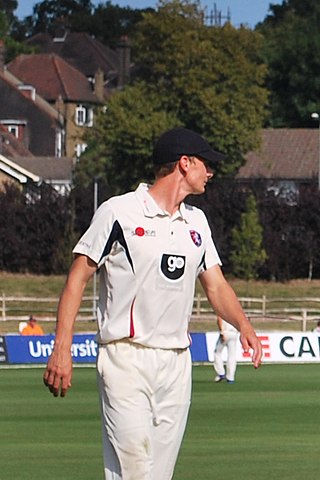Related Research Articles

Nottinghamshire County Cricket Club is one of eighteen first-class county clubs within the domestic cricket structure of England and Wales. It represents the historic county of Nottinghamshire. The club's limited overs team is called the Notts Outlaws.

Arthur Shrewsbury was an English cricketer and rugby football administrator. He was widely rated as competing with W. G. Grace for the accolade of best batsman of the 1880s;Grace himself,when asked whom he would most like in his side,replied simply,"Give me Arthur". An opening batsman,Shrewsbury played his cricket for Nottinghamshire County Cricket Club and played 23 Test matches for England,captaining them in 7 games,with a record of won 5,lost 2. He was the last professional to be England captain until Len Hutton was chosen in 1952. He was a Wisden Cricketer of the Year in 1890. He also organised the first British Isles rugby tour to Australasia in 1888.

Derek William Randall is an English former cricketer,who played first-class cricket for Nottinghamshire,and Tests and ODIs for England in the late 1970s and early 1980s.

William Barnes was an English professional cricketer who played for Nottinghamshire County Cricket Club from 1875 to 1894,and in 21 Test matches for England from 1880 to 1890. He was born at Sutton-in-Ashfield,Nottinghamshire,and died at Mansfield Woodhouse,Nottinghamshire.

William Wilfrid Whysall,generally known as "Dodger" Whysall,was an English professional cricketer who played for Nottinghamshire County Cricket Club from 1910 to 1930,and in four Test matches for England from 1925 to 1930. He was born at Woodborough,Nottinghamshire,and died in a Nottingham hospital.
William Walter Keeton was an English cricketer who played in two Tests in 1934 and 1939. He was a Wisden Cricketer of the Year in 1940 and played first-class cricket as a right-handed opening batsman between 1926 and 1952 for Nottinghamshire. Keeton scored a century against every other first-class county and his 312 not out made in just under eight hours against Middlesex at the Oval in 1939 is still a record for the Nottinghamshire team.

William Clarke was an English cricketer and team manager who played first-class cricket from 1826 to 1855. He founded,managed and captained the All-England Eleven. He has been described as "one of certain figures who,in the history of cricket,stand like milestones along the way". Clarke was born at Nottingham and died at Wandsworth in Surrey.
In English cricket,the years 1826–1845 were dominated by the roundarm bowling issue,which was resolved when the style was legalised in 1835,and by the formation of the first modern county clubs between 1839 and 1845.
The Sheffield Cricket Club was founded in the 18th century and soon began to play a key role in the development of cricket in northern England. It was the direct forerunner of Yorkshire County Cricket Club and some of the teams fielded by Sheffield were styled Yorkshire. Sheffield generally held first-class status,depending on the quality of their opponents,from 1827 to 1855.
Harry Butler Daft was an English footballer who played for Notts County,with whom he won the FA Cup in 1894,as well as making five appearances as a left winger for the national side. He was also an accomplished first-class cricketer,playing 200 matches for Nottinghamshire between 1885 and 1899.

William Robert Simon Gidman is an English former professional cricketer who most recently played for Kent County Cricket Club as an all-rounder. He previously played county cricket for Durham,Gloucestershire and Nottinghamshire and spent a period on loan at Kent towards the end of the 2016 season before joining the club permanently in October 2016.
William Jefferies or William Jeffries,was an English professional cricketer. He was active through the years 1800–1818 when he played for Nottingham Cricket Club.
William Pellett was an English cricketer. Pellett's batting and bowling styles are unknown. He was born at Duncton,Sussex.
John Oscroft was an English cricketer. Oscroft's batting and bowling styles are unknown. He was born at Arnold,Nottinghamshire.
Henry Clinton Attenburrow was an English first-class cricketer. Attenburrow's batting style is unknown,though it is known he bowled right-arm underarm slow. He was born at Nottingham,Nottinghamshire.
William Upton was an English cricketer. Upton's batting style is unknown. He was born at Cotgrave,Nottinghamshire.
William Woodward was an English first-class cricketer who played for Nottingham Cricket Club. Woodward's batting style is unknown,though it is known he occasionally played as a wicket-keeper. He was born in Nottingham,where he was christened on 26 November 1813;died in Barrie,Ontario.
William Henry Woolhouse was an English cricketer active in the 1820s and 1830s,making seventeen appearances in first-class cricket. Born at Sheffield,Yorkshire,Woolhouse was a left-handed batsman and left-arm roundarm bowler,who played for several first-class cricket teams. He was most notable as a founding member of The Wednesday Cricket Club,which organised early county matches in Yorkshire,and along with his father-in-law George Steer he was also behind the establishment of both the Darnall Old Ground and Darnall New Ground.
George Grainger Brown was an English cricketer active in the 1850s,making over forty appearances in first-class cricket. Born at Brighton,Sussex,Brown was a right-handed batsman and an underarm bowler,who played for several first-class cricket teams.
References
- ↑ "First-Class Matches played by William North". CricketArchive. Retrieved 20 February 2013.
- ↑ "First-class Batting and Fielding For Each Team by William North". CricketArchive. Retrieved 20 February 2013.